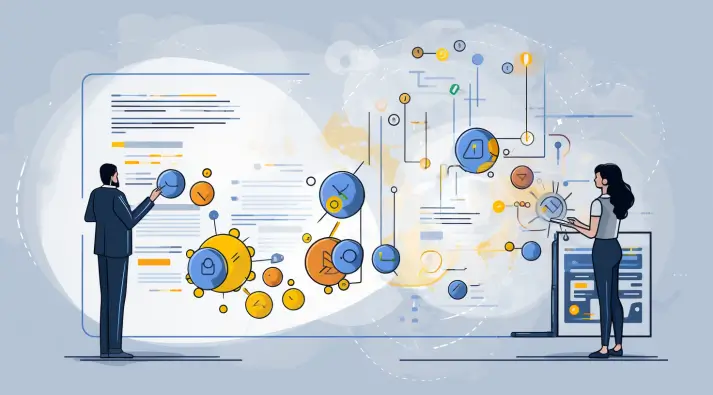Email list migration Tools is a critical task that involves the careful transfer of email data from one service provider to another. Factors for a successful migration include in-depth planning, clear communication with stakeholders and end-users, ensuring email migration software compatibility, training on the new platform, prioritizing data to migrate, handling downtime effectively, maintaining stringent security measures, and performing both pilot and final migration validations. Utilizing professional migration services like CloudFuze, which specialize in not only email but also cloud data transfers, can simplify the process and minimize risks associated with data security, downtime, and email deliverability. In this article, we will discuss essential steps, tips, and tools for smooth email list migration.
Key Takeaways
- Detailed planning is essential for successful email list migration.
- Utilize professional migration services like CloudFuze for seamless transitions
- Train end-users on the new platform for smooth adaptation to the changes.
- Choose migration tools that are compatible and scalable to organizational needs.
- Prioritize security measures to protect migrated data.
- Minimize downtime by selecting the optimal time and having contingency plans.
- Post-migration analysis is crucial to ensure data integrity and campaign continuity.
Understanding the Importance of Email List Migration
Businesses increasingly recognize the importance of email list migration to access better features, improve email deliverability, and enhance overall email marketing effectiveness. One critical factor prompting a migration is the limitations of current email service providers (ESPs) in functionality, deliverability, customer support, and the ability to seamlessly integrate email with other communication channels like SMS.
Migrating to a new ESP empowers businesses to harness advanced email marketing tools and maintain a competitive edge in today’s fast-paced marketing landscape.
A successful migration not only involves finding the right Email List Migration Service, Migration Tools for Email Lists, and Email List Transfer Software, but also focuses on preserving the integrity and continuity of existing email marketing campaigns to maximize revenue and customer engagement.
- Expanding functionality with innovative features
- Boosting email deliverability and reputation
- Efficiently integrating email with other channels
- Upgrading to a more reliable customer support
- Optimizing cost-effectiveness
The table below highlights some common reasons and potential benefits of migrating to a new ESP:
| Reasons for Migration | Potential Benefits |
|---|---|
| Limited features and functionality | Access to advanced email marketing tools |
| Poor email deliverability | Increased inbox placement rates and sender reputation |
| Inadequate customer support | Improved response times and expert guidance |
| Integration limitations | Seamless linking to other communication channels and marketing tools |
| High costs for limited services | Optimized pricing with better service offerings |
In conclusion, a well-planned email list migration can provide businesses with the opportunity to harness advanced email marketing features, optimize email deliverability, and ultimately enhance customer engagement. By carefully selecting the right migration tools and services, organizations can ensure a seamless email list transfer while preserving the integrity and continuity of their email marketing campaigns.
The Initial Steps: Preparing for Your Email List Migration
Preparing for a successful email list migration requires a well-defined strategy that encompasses clear communication, comprehensive planning, and optimal timing. Following email list migration best practices and utilizing efficient email list transfer software can significantly reduce downtime and ensure a smooth transition to the new platform.
Communicating with Stakeholders and Training End-Users
A critical aspect of any email migration is ensuring that stakeholders are well informed and have a clear understanding of the expected impact of the migration. Being transparent about the migration plan and its potential effects eases the transition and promotes a smooth adaptation process. In addition, providing email platform training to end-users through demonstration sessions ahead of time will help them become familiar with the new system, reducing resistance and downtime.
Creating a Comprehensive Migration Plan
Developing a detailed email migration plan is essential to minimize risks and ensure that all aspects of the process are covered. This plan should include:
- Identification of the data to be migrated, such as emails, calendars, tasks, distribution lists, and attachments
- Determination of desired outcomes and timelines
- Creation of an exhaustive email migration checklist to prevent oversights
- Evaluation of hardware and software requirements
- Selection of appropriate email list migration software
Choosing the Right Time for Migration
Selecting the right time for the migration is crucial as it minimizes disruption to ongoing business processes. Consideration should be given to the organization’s schedules and activities, ensuring that the migration takes place during a period of minimal impact. By carefully planning the email list migration timing, disruptions can be significantly reduced, contributing to a smooth and efficient transfer of email data.
“Carefully planning the email list migration timing reduces disruptions and contributes to a smooth and efficient transfer of email data.”
| Milestone | Task Description | Timeline |
|---|---|---|
| Stakeholder Communication | Inform stakeholders about migration plan, software, and execution details | 2 weeks before migration |
| End-user Training | Conduct demonstration sessions and provide necessary training materials | 1 week before migration |
| Migration Plan Development | Create a detailed migration plan including timelines, checklist, and software requirements | 3 weeks before migration |
| Time Selection | Choose the best possible time for migration, minimizing business disruptions | 1 month before migration |
In conclusion, effectively preparing for an email list migration by communicating with stakeholders, training end-users, creating a comprehensive plan, and selecting the right time will contribute significantly to the overall success of the migration process. By following these best practices and utilizing efficient email list migration software, organizations can minimize downtime and unlock the full potential of their new email platform.
Evaluating and Selecting Email List Migration Tools
Selecting the right email list migration tools is crucial for facilitating a seamless transfer of data from the source to the destination platform. To choose the most suitable tools, one must consider their compatibility with both platforms, their ability to handle incremental migrations, and scalability. Additionally, ensuring that the chosen tools comply with industry-standard security regulations is a vital consideration for a successful migration.
Email migration software compatibility is a key factor when evaluating different migration tools. Proper compatibility allows for a smooth and efficient migration process, with minimal disruptions to ongoing email marketing campaigns. To assess compatibility, compare the requirements and capabilities of both source and destination platforms. This comparison helps identify any potential limitations or roadblocks, ensuring a hassle-free migration experience.
A tool’s capability to handle incremental migrations and scalability to meet organizational demands is crucial for sustaining email marketing growth. Incremental migrations enable a gradual transfer of email data, reducing the risk of downtime. Scalability is essential as the email list is expected to expand over time, and the migration tool should be capable of accommodating this growth.
Verify if the chosen migration tools align with best practices, provide necessary encryption and authentication (such as OAuth 2.0), and comply with industry-standard security regulations.
Security is an important aspect when selecting email list migration tools. The tools employed must conform to industry-standard security regulations, such as encryption and authentication methods (e.g., OAuth 2.0). Adherence to these standards minimizes the risk of unauthorized access to sensitive email data, ensuring a secure transfer process.
- Evaluate compatibility with source and destination platforms
- Assess the capability for incremental migrations and scalability
- Verify adherence to best practices and security regulations
In conclusion, selecting the most appropriate email list migration tools involves evaluating the compatibility with both source and destination platforms, their capability to handle incremental migrations and scalability, and their security features. By considering these essential factors, organizations can facilitate a successful email list migration and continue to grow their email marketing efforts.
Ensuring Compatibility and Seamless Integration
Ensuring compatibility between the migration tool and email platforms is crucial in preventing roadblocks and facilitating a seamless data transfer process. This involves conducting compatibility checks that cover the ability of the migration tool to perform both one-time and incremental migrations, with the flexibility to scale as per the organization’s needs. Proper integration is fundamental to a smooth transition of data and continuity of email campaigns.
| Compatibility Factors | Description |
|---|---|
| One-time Migrations | A migration tool must support the transferring of all the required data in a single pass, ensuring minimal impact on email campaign performance. |
| Incremental Migrations | For organizations with an ongoing need for data transfers, a migration tool should support incremental migrations, which allow for transferring data in smaller segments over time. |
| Scalability | The migration tool must be able to handle the organization’s data growth and adjust to fluctuating transfer demands, without compromising on data integrity and transfer efficiency. |
| Platform Compatibility | The tool should seamlessly integrate with both source and destination platforms, ensuring smooth data transfers without the need for extensive customization or adjustments. |
Seamless Data Transfer is achieved when the migration process is smooth, efficient, and with minimal disruption to ongoing email campaigns. This can be accomplished by choosing a compatible migration tool and properly integrating it with existing email platforms.
“Compatibility and seamless integration are essential for a successful email list migration.”
- Select a migration tool that supports the required data transfer types (one-time, incremental, or both)
- Confirm platform compatibility and the tool’s adherence to industry-standard security regulations
- Verify the tool’s scalability and flexibility to accommodate your organization’s needs
- Ensure a proper integration process, leaving no gaps in email campaign continuity
By prioritizing compatibility and seamless integration, businesses can ensure a smooth, efficient email list migration experience, resulting in minimal disruptions to ongoing email marketing campaigns. Taking the necessary precautions can pave the way for future success within the email marketing realm.
Streamlining the Migration Process with Automation

Automation is a powerful approach to streamline the email list migration process, as it offers significant efficiency gains. Migration software can automate the transfer of emails and associated data, potentially reducing the need for manual intervention and decreasing error rates. By utilizing tools with advanced automation features, organizations can ensure an efficient and reliable migration experience.
Utilizing Email List Migration Software for Efficiency
Email list migration software is designed to simplify the migration process, enabling users to transfer their email lists and associated data between email service providers with ease. Some popular migration tools include CloudFuze, Mimecast, and Transend Migrator, which offer features like incremental migration, data filtering, and detailed reporting. By selecting a suitable migration tool with a strong track record, businesses can improve the overall efficiency and success of their email list migration.
Batch Processing and Data Mapping Strategies
Batch processing methodologies are used to migrate data in segments, making the entire process manageable and minimizing the risk of overwhelming the involved systems. This approach allows organizations to monitor the progress of the migration and quickly address any issues that may arise.
Data mapping strategies, on the other hand, are essential to ensure the accurate relocation of data fields from the source to the destination platforms. They involve the creation of detailed mapping plans that match data fields and structures between the original and target databases, thereby maintaining data integrity and proper organization.
“Organizations can leverage batch processing and data mapping strategies to efficiently transfer their email lists, while preserving the consistency and structure of the source data.”
- Select a suitable email list migration software that supports batch processing and data mapping.
- Divide the email list data into manageable segments or batches for migration.
- Create a detailed data mapping plan that matches data fields and structures between the source and destination platforms.
- Test the migration process on a smaller scale to identify and address potential issues before full-scale migration.
- Monitor and validate the migration process to ensure proper transfer of data and maintain data integrity.
In conclusion, streamlining the email list migration process with automation, batch processing, and data mapping strategies can significantly increase the efficiency of the process. By utilizing these methods and selecting suitable migration software, organizations can minimize potential problems and ensure a successful email migration outcome.
Prioritizing Data Security During Email List Transfer
Data security is paramount during the email list migration process. Ensuring the protection of sensitive information and safeguarding against unauthorized access is crucial for maintaining trust and credibility. Employing migration tools that provide robust encryption, authenticate both source and destination platforms, adhere to security best practices, and comply with regulation standards is imperative to achieve a secure email list transfer.
Some key factors to consider when selecting an email migration tool with a focus on data security include:
- Encryption capability for data in transit and at rest
- Authentication mechanisms for source and destination platforms
- Compliance with industry-standard security regulations (such as GDPR, HIPAA, etc.)
- Reputation and track record of the tool in the market
These elements help ensure that data remains secure during the migration process, protecting sensitive information from potential breaches and unauthorized access.
“Prioritizing security settings within the migration tool prevents unauthorized access and potential data breaches.”
To further enhance data security during migration, organizations should also implement additional best practices:
- Perform a risk assessment to identify potential vulnerabilities and develop mitigation strategies
- Implement strict access controls for migration tools and systems
- Conduct regular audits and monitoring during the migration process
- Have a contingency plan in place in case of unexpected security incidents
By proactively addressing data security measures, organizations can mitigate risks and ensure a successful, secure email list transfer, protecting their valuable information and maintaining client trust.
Effective Strategies for Minimizing Downtime
Email migration downtime can negatively impact business operations, making it essential to employ effective strategies that minimize disruptions and maintain productivity. In this section, we’ll explore contingency planning and quick recovery procedures to ensure a smooth email migration experience.
Planning for Contingencies and Quick Recovery
Thorough contingency planning and a focus on quick recovery are vital to mitigating potential downtime during email list migrations. The following steps detail a comprehensive approach to navigating unforeseen challenges:
- Create a detailed data backup: Ensure that a complete data backup is in place before initiating the migration process. This provides a safety net for recovering lost or corrupted data during migration.
- Develop data recovery plans: Devise plans for addressing migration failures and data recovery situations, outlining clear steps to rectify issues that may emerge during the email list transfer.
- Conduct pilot migrations: Running controlled pilot migrations can help identify potential risks and setbacks, giving organizations the chance to rectify issues before the main migration.
- Allocate adequate resources: Proper resource allocation, including dedicated personnel, hardware, and software, is crucial for ensuring the efficient execution of migration tasks and addressing any problems that may arise.
- Establish clear communication channels: Maintain open communication with stakeholders and end-users throughout the migration process. This helps facilitate a quick response to issues and keeps all parties informed of progress and potential threats.
“To minimize downtime, robust strategies include thorough contingency planning and establishing quick recovery procedures.”
Implementing these measures can help maintain business operations during the migration process and instill confidence in the email migration service. By mitigating downtime and ensuring a swift response to unexpected challenges, organizations can support a smooth email list migration, enabling teams to focus on enhancing their email campaigns and leveraging the benefits of their new email service provider.
Post-Migration Considerations: Verification and Validation
After completing the email list migration, it is essential to focus on verification and validation to ensure the transferred data meets the set objectives and requirements. This step assures the integrity of the data and confirms that the migration process has been successful.
- Email List Migration Verification: Review the email migration reports to verify that all data has been transferred accurately. Pay attention to the emails, distribution lists, calendars, and other elements essential for a successful migration.
- Email Migration Validation: Compare the transferred data with the source platform to identify any discrepancies. Rectify any issues to ensure that the destination platform has all the necessary data in the correct format.
| Verification Activity | Description | Benefits |
|---|---|---|
| Reviewing migration logs | Examine records of migrated data and user accounts, including email addresses, distribution lists, and shared calendars. This helps in identifying any missing or problematic items. | Ensures that all data is moved over accurately, with no missing elements. |
| Checking user access and permissions | Confirm that all users can access their accounts and have the appropriate permissions in the destination platform. | Maintains a smooth user experience and prevents unauthorized access to sensitive information. |
| Testing email workflows | Validate that email marketing workflows function correctly after the migration, including automations and triggered email campaigns. | Guarantees that email marketing efforts are not disrupted and can continue effectively post-migration. |
It is essential to address any discrepancies found in the validation process to maintain the overall integrity and effectiveness of your email marketing campaigns after the migration. A well-executed post-migration verification and validation will provide confidence in the success of the email list migration process and contribute to the enhancement of future marketing efforts.
“The post-migration validation process confirms the success and integrity of the email list migration, ensuring that all vital elements of your email marketing strategy continue to function effectively.”
Enhancing Email Campaigns with Advanced ESP Features
Utilizing a powerful Email Service Provider (ESP) with advanced features is essential for driving increased revenue and engagement through email marketing campaigns. After migrating to a new platform, marketers can benefit from the advanced tools available to streamline their email efforts and achieve better results.
Leveraging Automation and Personalization
Email Campaign Automation and Personalized Email Campaigns are essential aspects of a successful email marketing strategy. By employing an ESP with cutting-edge automation features, marketers can send tailored campaigns and trigger emails based on subscribers’ behaviors and preferences. This approach helps to optimize engagement rates and improve overall revenue generation.
Advanced automation and personalization tools empower marketers to send finely targeted communications at scale, enhancing both the efficiency and efficacy of their email campaigns.
Improving Deliverability and Performance Analytics
A key component of a successful email marketing campaign is ensuring high Email Deliverability Improvement. A robust ESP will implement strong deliverability practices, such as proper authentication methods and up-to-date reputation management, to ensure that emails reach their intended recipients.
To further refine their email campaigns, marketers should leverage Email Performance Analytics provided by their ESP. These analytics tools can help identify engagement trends, optimize campaigns for better performance, and drive continuous improvements in email marketing strategy.
| Key Feature | Benefits |
|---|---|
| Email Campaign Automation | Streamlines campaign management, enables trigger-based emails, and enhances efficiency |
| Personalized Email Campaigns | Improves engagement rates, fosters stronger connections with subscribers, and drives revenue growth |
| Email Deliverability Improvement | Increases email reach, maintains sender credibility, and supports long-term campaign success |
| Email Performance Analytics | Identifies trends, pinpoints opportunities for optimization, and fosters continuous improvement |
By taking advantage of advanced ESP features, marketers can elevate their email campaigns, strengthening the connection with their subscribers and ultimately boosting the overall success of their email marketing efforts post-migration.
Conclusion
Email list migration success depends on meticulous planning, selection of appropriate migration tools, and prioritizing data security and compatibility. A seamless email transition preserves the integrity of email campaigns and ensures continuity, which in turn, boosts engagement rates and marketing revenue. By adhering to best practices during the email migration process, organizations can take advantage of advanced ESP features, drive performance improvements, and guarantee the effectiveness of future marketing efforts.
Preparing for a migration requires open communication with stakeholders and end-users, comprehensive migration planning, and selecting the optimal time for a smooth transition. Ensuring compatibility between migration tools and email platforms, along with robust security measures during the transfer, safeguards valuable data and maintains sender credibility. Once migrated, businesses should focus on leveraging advanced ESP features such as automation, personalization, deliverability enhancement, and performance analytics to optimize their email marketing campaigns.
In conclusion, a well-executed email list migration, which emphasizes preparation, security, compatibility, and minimal downtime, sets an organization up for success in their email marketing endeavors. By utilizing the right strategies and tools at every step, businesses can enjoy a seamless email transition, improved campaign performance, and increased return on investment.
What Email List Migration Tools Are Compatible with Responsive Email Campaigns?
When it comes to email list migration tools, it’s important to choose top choices for responsive email campaigns to ensure compatibility. Some of the top choices for responsive email include Mailchimp, Constant Contact, and Sendinblue. These tools allow for seamless migration and ensure that your email campaigns are optimized for all devices.
FAQ
Why is email list migration important?
Email list migration is essential for accessing better features, improving email deliverability, and enhancing overall email marketing effectiveness. It allows businesses to overcome limitations in functionality, customer support, and seamless integration with other communication channels.
How do I prepare for an email list migration?
Preparation involves transparent communication with stakeholders, training end-users on the new platform, creating a comprehensive migration plan, and choosing the right time for migration to minimize disruption and maintain business continuity.
What factors should I consider when selecting email list migration tools?
Important factors include compatibility with both source and destination platforms, capability to handle incremental migrations, scalability, alignment with best practices, encryption, authentication, and compliance with security standards.
How can I ensure compatibility between my migration tool and email platforms?
Ensure compatibility by verifying the tool’s capacity for one-time and incremental migrations, scalability, and seamless data transfer between the source and destination platforms.
How can automation help with email list migration?
Automation streamlines the email list migration process, offering efficiency gains by reducing manual intervention and error rates, and providing a more reliable migration experience.
What is the role of data security during email list migration?
Data security is crucial to protect sensitive information, prevent unauthorized access, and ensure compliance with regulation standards. It involves employing migration tools that provide robust encryption, authenticate both source and destination platforms, and adhere to security best practices.
How do I minimize downtime during email list migration?
Minimizing downtime requires thorough contingency planning, establishing quick recovery procedures, backing up data, and having plans in place for data recovery in case of migration failures.
What should be my focus after the completion of email list migration?
Post-migration activities include verification and validation of the migrated data, leveraging advanced ESP features like automation and personalization, improving email deliverability rates, and conducting comprehensive performance analytics to optimize your email campaigns.



